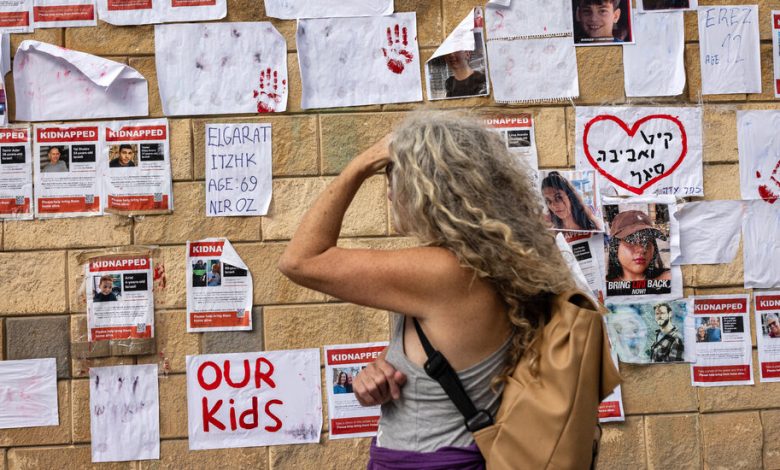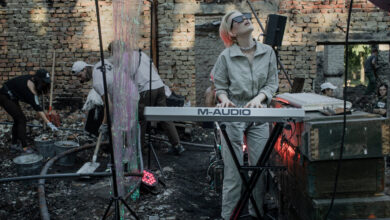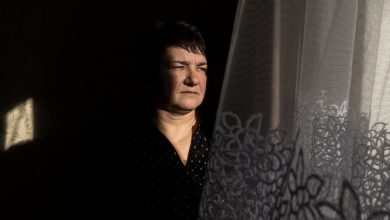Hamas Hijacked Victims’ Social Media Accounts to Spread Terror

Shortly after Hamas attacked Israel on Oct. 7, friends and relatives of Gali Shlezinger Idan, who lived in a kibbutz near the Gaza border, received frantic messages to check her Facebook page.
What they found shocked them. Hamas members were using Ms. Idan’s Facebook account to livestream themselves holding her and her family hostage. During the 43-minute broadcast, gunmen forced Ms. Idan and her family to crouch on a tile floor as missiles and gunfire blasted their building.
“I couldn’t believe what I was seeing,” said Keren de Via, a friend of the Idan family who watched Ms. Idan’s children hug their parents and cry during the livestream. “How could we watch them terrorize the family like this? How could I watch this on Facebook?”
In a new war tactic, Hamas has seized the social media accounts of kidnapped Israelis and used them to broadcast violent messages and wage psychological warfare, according to interviews with 13 Israeli families and their friends, as well as social media experts who have studied extremist groups.
In at least four cases, Hamas members logged into the personal social media accounts of their hostages to livestream the Oct. 7 attacks. In the days since, Hamas also appeared to infiltrate their hostages’ Facebook groups, Instagram accounts and WhatsApp chats to issue death threats and calls for violence. Hamas members also took hostages’ cellphones to make calls to taunt friends and relatives, according to the Israeli families and their friends.
Extremist groups have long turned to social media to further their causes by livestreaming attacks and posting propaganda. But hijacking individual hostages’ Facebook, Instagram and WhatsApp accounts “weaponizes social media in a way I don’t think we’ve seen before,” said Thomas Rid, a professor of strategic studies at Johns Hopkins University. “We are not psychologically prepared for this.”
The tactic is particularly harrowing for those close to the account owners, compounding an already distressing situation.
Social media has become a lifeline for friends and family searching for clues about missing loved ones, and receiving a message or seeing a video posted to the accounts immediately inspired a moment of hope, said two of the families whose relatives were taken hostage by Hamas. But that fizzled when they saw that someone else had made the posts.
“I felt maybe hopeful, for a second — and then confused,” Ms. de Via said. “Then just terror.”
Meta, which owns Facebook, Instagram and WhatsApp, declined to comment on the commandeering of kidnapped Israelis’ social media accounts but said it had established a “special operations center staffed with experts, including fluent Hebrew and Arabic speakers, to closely monitor and respond to this rapidly evolving situation.”
Two members of the security team that oversees Facebook, who declined to be identified because they were not authorized to speak publicly, confirmed that Hamas had gotten access to the Facebook accounts of Israelis who were taken hostage to start livestreams and post to their accounts. This appeared to be part of Hamas’s strategy from the moment the attacks happened, they said. The accounts have since been made private and the livestreams removed, they added.
Hamas representatives did not respond to requests for comment.
Ms. Idan’s Facebook account was seized on Oct. 7, roughly two hours after Hamas attacked her kibbutz, Nahal Oz, where she lived with her husband and four children. Suddenly, a livestream appeared on her Facebook page, Ms. de Via and a relative of the family said.
Ms. de Via, who was once a neighbor of Ms. Idan’s and has children the same age, said she had been trying to reach her when the live video popped up.
“I immediately opened it because she is not someone who makes Facebook videos or does a livestream,” Ms. de Via said. “The first thing I saw was how terrified the children looked, and then voices in Arabic. I understood something very bad was happening.”
A recording of the livestream shows Ms. Idan, 50, and her husband, Tzachi, 51, crouched on a floor with their two youngest children, a girl and a boy. The boy, 7, was crying and asking, “Where is my sister?”
“It is then I understood, his two older sisters are not there,” Ms. de Via said. “And then I saw the blood on Tzachi’s hands and I thought the worst.”
Medical personnel later found the body of Ms. Idan’s oldest daughter, Mayan, who had recently turned 18. She had been shot. The couple’s third daughter, Sharon, was not at home, Ms. de Via said. Ms. Idan and her children were eventually left at home; her husband was taken hostage.
Hamas also took control of the Facebook account of Dikla Arava, 50, another Nahal Oz resident. The attackers used the account to begin a livestream. During the 20-minute broadcast, Ms. Arava’s teenage son was forced to go outside and tell his neighbors that it was safe and that they should come out.
Two of Ms. Arava’s relatives, who viewed the video and shared the recording with The New York Times, said it was horrifying that gunmen had used the teenager to try to lure other people. Ms. Arava, her partner and their three children were all kidnapped by Hamas. Last week, a video was posted on a Hamas-affiliated Telegram channel showing one of Ms. Arava’s teenage daughters in Gaza.
A live video also began on Oct. 7 on the personal Facebook account of Bracha Levinson, a resident of the Nir Oz kibbutz near Gaza. She was seen lying immobile on the ground in a pool of blood, surrounded by men holding weapons, said Galya Shishitzky, who grew up with the Levinson family. Ms. Levinson’s home was later burned to the ground.
“We didn’t understand what was going on,” Ms. Shishitzky said of the chaos. She could not wrap her mind around how members of Hamas were in the home of Ms. Levinson, “a second mother to me,” and did not click on the Facebook livestream because she was in shock.
“How could this happen?” she said.
Shir Matan, a student in Tel Aviv whose 27-year-old cousin disappeared after attending the Tribe of Nova music festival, which was attacked by Hamas, said several strange posts had appeared on her cousin’s Instagram page five hours after the raid.
“There were voices in Arabic, and just feet shuffling,” Ms. Matan, 31, said. “Then someone said, in Arabic, ‘Slut.’” The video was deleted after 10 minutes, and nothing has been posted to the account since, she said. She declined to name her cousin for fear of harassment.
Two Israeli families said they had also seen posts with a single word in Arabic — death — appear on their missing loved ones’ Facebook pages before being deleted. Hamas also used the phones of kidnapped and dead Israelis to upload photos and videos after the attack, said family members who received them.
Many Israelis have continued pleading for information across social media networks, seeing it as the only way to give voice to the hostages and hope to their families.
Lian Gold, a DJ in Tel Aviv who knew many people who were working at and attending the Nova festival, near the Gaza border, has created an Instagram page and a Telegram channel called WeAreOneIsrael to share images and contact information of those who are missing.
“I’m receiving messages asking me, ‘Please, please help me, please, please, please,’” Ms. Gold said. “So what can I do? I just post it and hope to find anything.”
Lisa Lerer contributed reporting.





